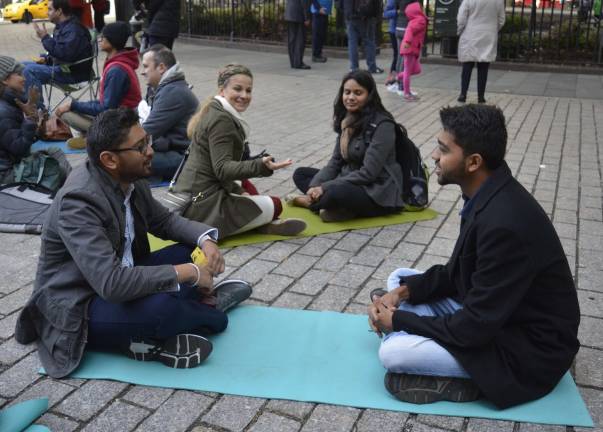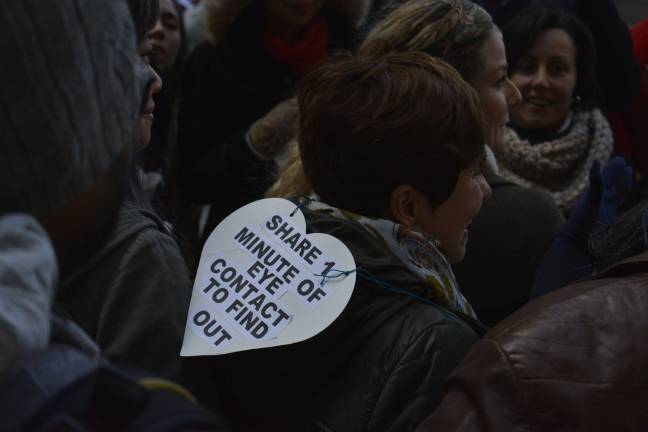connecting, in person


BY DIAMOND NAGA SIU
People hugged, held hands and gazed into strangers’ eyes. They faced each other while sitting on colorful yoga mats and patterned pieces of cloth. Everybody connected — without using electronic devices.
The Saturday morning gathering at Bowling Green Plaza was the New York City version of The World’s Biggest Eye Contact Experiment. It was started by The Liberators International, a nonprofit organization that tries eliciting greater human connection through coordinating, recording and distributing monthly global acts of unity.
“It’s not easy or a miracle solution, but I think eye contact is a start of fixing the things that are broken in this world,” said Patrick Patterson, 54, visiting from Canada. “Just with eye contact, you can feel incredibly open and vulnerable, which I think we’re missing in this world.”
He also tried heightening his level of connection by expanding beyond one-on-one sessions and attempted some group gazing.
Amy Silverman, host of the Bowling Green event, said she wanted to play her part in connecting human beings.
“It brings me back into the present moment, and it reminds me of the wonderment of people and lets us connect with our mutual humanity,” Silverman said of the occasion.
A call to participate was broadcast on, of course, Facebook, where more than 1,000 people responded. Although this year’s New York event was smaller than last year’s, which was held along Broadway from Houston Street to 49th, people were able to create longer, stronger bonds and experienced a more intimate environment, Silverman said. If last year’s event drew more people, it was also more diffuse, with groups 10 people gathering along Broadway and engaging passers-by as participants. Most stopped only momentarily and then continued on their way.
This year’s event was more cohesive, she said.
“People could spend more time together and relate to each other and talk with each other and build on the connections they make,” Silverman said. “My intention is to make this monthly — send a small group of people out to different parts of the city so that we can keep the momentum going and keep people engaged.”
Diane Hollman, a global host for the eye contact experiment, which has taken place in about three dozen countries, said she learned about the initiative through a friend who participated in a Tel Aviv, Israel, session last year. After realizing how much more connected her friend felt to other people, the two decided to bring the event to Philadelphia and now cohost the New York City one with Silverman.
“I am hungry for deeper human connection and am gifted to have so many wonderful people in my presence,” Hollman said. “Every single gazing I did with people affected me deeply and expanded my heart.”
Hollman, a director of business management, said she has spent more than four decades studying how different variables such as awareness, food and thought patterns affect people’s health. She’s now exploring eye contact’s role in well-being.
Not every participant felt so comfortable by the prospect of a concentrated connection. Chris Motola, a 38-year-old writer, volunteered to help facilitate the event to conquer his own fear of eye contact.
“It seemed a little scary, and I generally avoid human interaction, so I went against my instincts and signed up,” Motola said. “It’s good to be able to do eye contact without second-guessing yourself.”
He said that while many people chose to conduct the experiment without talking, he enjoyed conversing with people. Motola likened the silent eye gazing to a meditative practice.
When Patterson, the Canadian tourist, finished looking in other people’s eyes, he posted about the event on Facebook and encouraged his friends at home to attend the Vancouver version.
“It’s a moment, and that’s all it takes for true connection,” Patterson said. “Really, after today I’m just going to make more eye contact — to make more eye contact and to really connect.”